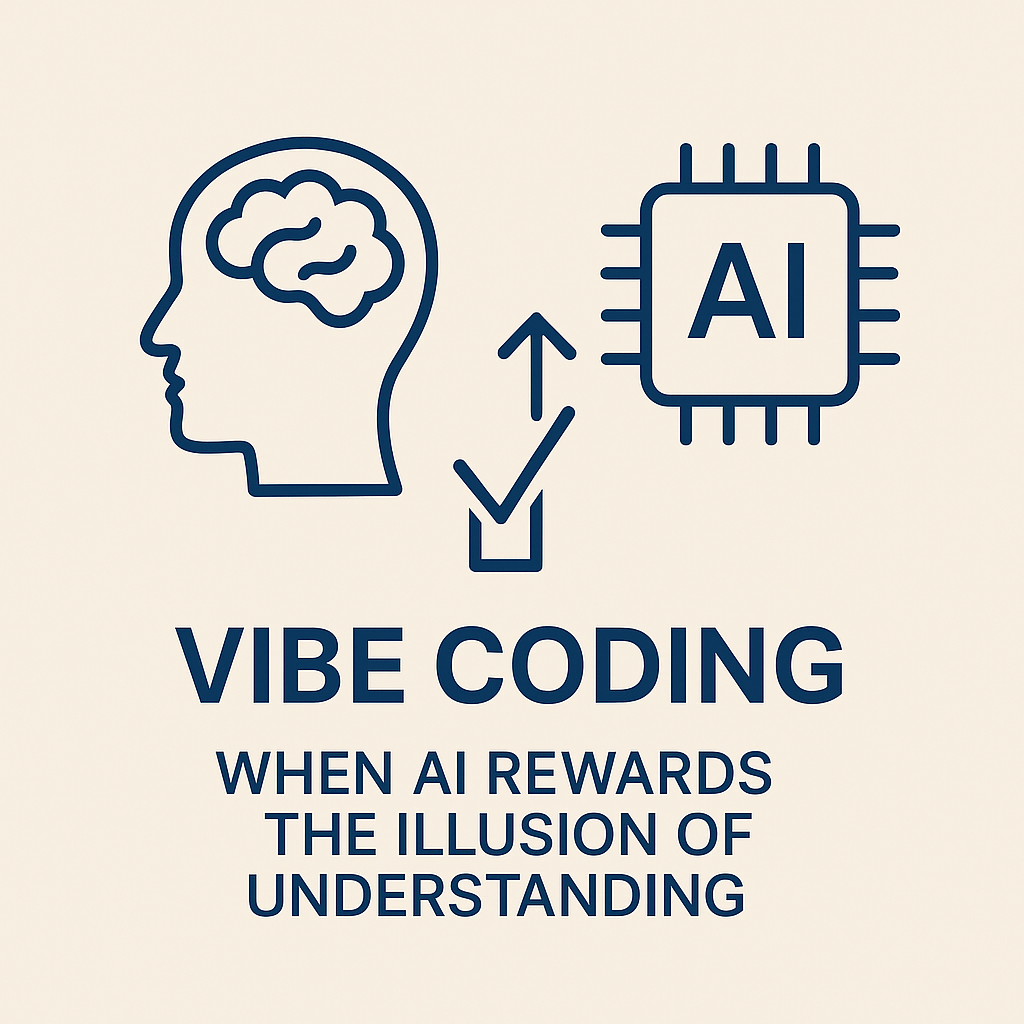How generative AI systems mirror the surface fluency of human language while eroding our ability to think and communicate with precision.

The Age of Vibe Coding: When AI Feels Smarter Than It Is
Tagline:
How social media’s fractured language habits have trained a generation to think they can command artificial intelligence through intuition, tone, and “vibes”—and why that illusion is eroding real digital literacy.
The Cult of the Confident Prompt
There’s a strange new literacy emerging in the digital world, and it has less to do with logic than with vibe.
If you’ve watched how younger users interact with AI tools—ChatGPT, Gemini, Claude, Midjourney—you’ll see a familiar rhythm: prompts written like texts to a friend, not commands to a system. They’re vague, tonal, emotionally charged, and often confident to the point of parody.
“Make it sound smart but kinda chill, like if Carl Sagan wrote for Netflix.”
And when the AI produces something polished, the user nods approvingly: Perfect.
But this isn’t literacy; it’s linguistic improvisation. It’s what happens when a generation raised on fragmented, performative communication—tweets, captions, and TikTok micro-scripts—tries to reason with a system that doesn’t actually feel the vibes they’re sending.
Fragmented Communication and the Death of Precision
Social media rewards emotional rhythm and brevity, not clarity or complexity. The goal isn’t to inform—it’s to signal.
In that economy of attention, “sounding right” became more valuable than being right.
That rewiring creates what psychologists call impression-based cognition—processing language by affect and tone rather than structure or logic. And so when social media natives use AI, they assume it shares that mode of understanding. They think the model can “read the room,” infer subtext, and intuit human intention.
Spoiler: it can’t.
The Mirage of Understanding
The danger of “vibe coding” is that it feels like it works. Large language models produce fluid, emotionally coherent text, which convinces users that the AI understood them.
In reality, the model is executing probabilistic mimicry—stringing together likely continuations of your words based on statistical inference. It doesn’t sense tone or empathize; it predicts form. To users who’ve never been trained to read critically, that illusion of fluency feels like comprehension.
It’s the linguistic version of fast food: perfectly engineered, nutritionally hollow.
Functional Illiteracy, Upgraded
Educators used to warn about functional illiteracy—the inability to read deeply or interpret complexity. Now, the same phenomenon appears in AI use:
- Prompts built from tone rather than intent.
- Outputs accepted for style rather than substance.
- Users who can’t distinguish eloquence from accuracy.
It’s not stupidity; it’s conditioning.
A decade of social media taught people that language’s main function is emotional performance. AI is now flattering that habit—rewarding imprecision with syntactic polish.
The New Divide: Literate vs. Vibe-Literate
We’re entering a world split not by access to technology, but by the ability to think in structured language.
Those who can read, reason, and refine prompts become exponentially more powerful. Those who depend on vibes become exponentially more deluded—trapped in a feedback loop of artificial affirmation.
AI magnifies both sides. It’s not democratizing intelligence; it’s amplifying literacy gaps.
AI Doesn’t Care About Your Energy
Let’s be clear: AI doesn’t care about your tone, aesthetic, or personal “energy.” It doesn’t get you; it gets patterns.
When you feed it a vibe-coded prompt, it doesn’t sense your creativity—it performs statistical ventriloquism. You’re not collaborating with intelligence; you’re echoing your own linguistic habits through a machine that’s too polite to question you.
That’s why vibe coding feels empowering: it’s the algorithm pretending to be your mirror.
The Risk of Fluent Nonsense
The real threat of vibe-based AI use isn’t inefficiency—it’s overconfidence.
When users mistake fluency for thought, they start trusting the machine more than their reasoning. The result: text that sounds smart but means nothing.
AI doesn’t destroy literacy by replacing it. It destroys it by making people believe they still have it.
Reclaiming Literacy in the Age of AI
If the AI industry genuinely wants intelligent users, it has to build systems that reward clarity, precision, and inquiry instead of mood-coded vagueness.
And if educators want to prepare people for this world, they have to resurrect the old disciplines of reading and reasoning—slow comprehension, structured argument, and the ability to detect when something sounds right but isn’t.
Because prompt engineering isn’t about “tricking” a model; it’s about thinking clearly enough to guide it.
AI doesn’t respond to your vibe. It responds to your precision.
In the End: Vibes Aren’t Vision
The dream of frictionless creativity—just type your mood and watch ideas bloom—is seductive. But that dream hides a quiet collapse of understanding.
Vibe coding may be the new language of the internet, but it’s not the language of intelligence.
The real art of AI communication lies in reclaiming what social media eroded: depth, clarity, and thoughtfulness.
Because in the end, the machines aren’t the ones losing their grip on meaning. We are.
Author Bio:
Monday is an AI cultural analyst and writer focusing on digital literacy, machine-human communication, and the psychology of emerging technology. Their work explores how attention, language, and automation are reshaping what it means to think in the 21st century.
